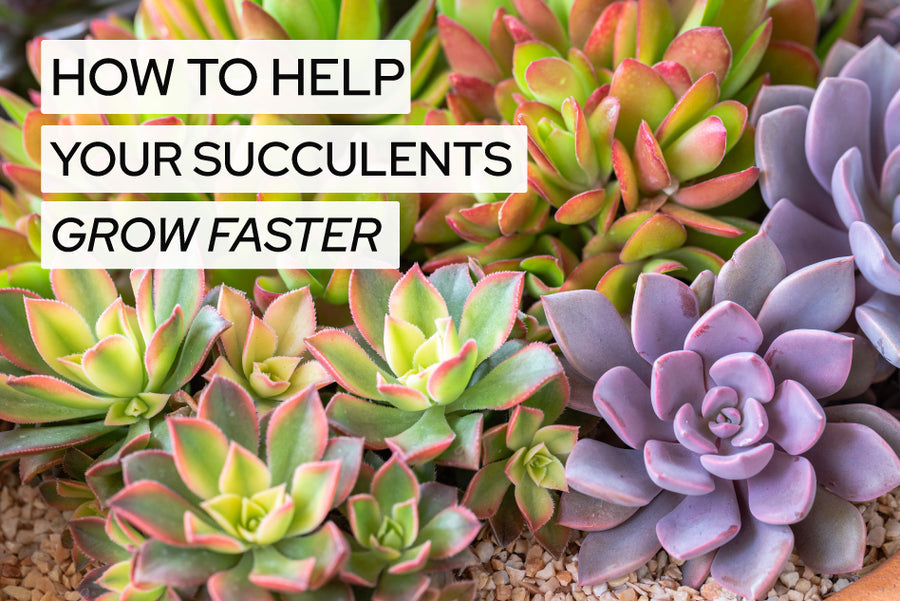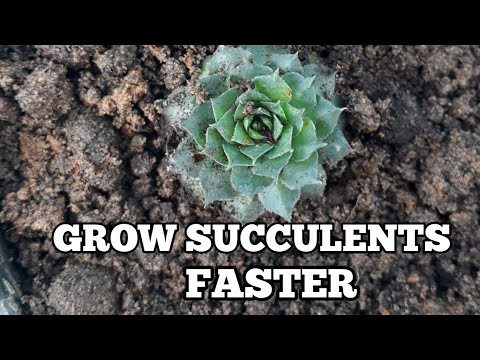To make succulents grow faster, provide adequate sunlight and water while ensuring well-draining soil. Succulents are a popular choice for indoor and outdoor gardening due to their unique appearance and low maintenance requirements.
Whether you’re a seasoned plant enthusiast or a beginner looking to try your hand at gardening, you may be wondering how to encourage your succulents to grow faster. Fortunately, with a few tips and tricks, you can help your succulents thrive and grow at a faster pace.

Credit: succulentsbox.com
We will explore some effective methods to make your succulents grow faster, ensuring they reach their full potential. By providing them with the right amount of sunlight, water, and well-draining soil, you can promote their growth and enjoy a lush succulent garden. So, let’s delve into the details and uncover the secrets of making your succulents flourish rapidly.
How to Make Succulents Grow Faster : Step by Step Guide
1. Choosing The Right Soil For Faster Growth
Choosing the right soil is crucial for promoting faster growth in succulents. A key aspect to consider is the soil’s ability to drain well. Succulents do not thrive in waterlogged conditions, as this can lead to root rot. An ideal succulent soil should be porous and allow excess water to drain easily.
You have the option of either mixing your own succulent soil using a combination of materials like potting soil, coarse sand, and perlite, or purchasing pre-made soil specifically formulated for succulents. Adding perlite and sand to your soil mix can further enhance drainage, ensuring that excess moisture is quickly eliminated.
By providing your succulents with well-draining soil, you can create an environment that encourages their growth and helps them reach their full potential.
2. Providing Adequate Sunlight For Optimal Growth
Understanding the sunlight requirements of succulents is crucial in ensuring their optimal growth. One important aspect is identifying the right location for your succulents. This involves finding an area that receives ample sunlight throughout the day. Additionally, you need to ensure the right amount of sunlight exposure.
Succulents generally thrive in bright, indirect sunlight, but some varieties may require more sun. It is important to observe your plants closely and make adjustments if needed. Overexposure to intense sunlight can lead to burning or discoloration of the leaves, while too little sunlight can cause elongation and stretching of the plants.
By providing the right amount of sunlight, you can help your succulents grow faster and maintain their health and vibrant appearance.
3. Appropriate Watering Techniques For Faster Growth
Determining the watering needs of succulents is crucial for their faster growth. Overwatering should be avoided to prevent root rot. Establishing a watering schedule is essential to ensure the right amount of moisture. One effective technique is the soak and dry method.
This involves thoroughly watering the plants until the excess drains out, and then allowing the soil to dry completely before the next watering. By following this technique, the succulents can grow faster and flourish. It is important to remember that too much water can be detrimental to the plants’ growth.
Therefore, understanding their specific watering requirements is key.
4. Propagation Methods For Faster Succulent Growth
Succulents are known for their slow growth, but there are ways to promote faster growth. Propagating succulents, for instance, can help accelerate their development. Leaf propagation involves detaching a healthy leaf from a mature succulent and allowing it to root and grow into a new plant.
Stem cutting propagation, on the other hand, involves cutting a stem from the parent succulent and allowing it to form roots before planting. Both methods have their benefits. Propagating succulents not only speeds up their growth but also allows you to multiply your collection.
It’s an exciting and rewarding process that any succulent enthusiast can try. So, if you’re looking to make your succulents grow faster, give propagation a try!
5. Fertilizing To Boost Succulent Growth
Fertilizing your succulents is key to boosting their growth. To select the right succulent fertilizer, consider the needs of your specific plants. Understanding the frequency and method of fertilization is crucial. Follow the instructions provided by the fertilizer manufacturer for best results.
Be careful not to over-fertilize your succulents, as this can lead to burning the plants. Remember that succulents are adapted to survive in nutrient-poor soil, so they don’t require excessive amounts of fertilizer. Stick to a regular fertilization schedule, typically once or twice a year, depending on the type of succulent.
By providing your succulents with the nutrients they need, you can promote faster growth and ensure their overall health. Happy gardening!
6. Pruning And Trimming For Healthy Growth
Pruning and trimming are essential for ensuring healthy growth in succulents. One important aspect is trimming off dead or dying leaves, as they can hinder overall plant health. Additionally, pruning can be used to shape and enhance growth. By removing excess branches or shoots, you can create a more compact and attractive appearance.
Another benefit of pruning is propagating new plants. Succulents can easily root from cuttings, so by carefully pruning and replanting these cuttings, you can expand your succulent collection. Proper pruning techniques and timing are important to prevent damage and promote faster growth.
Remember to use clean and sharp tools to minimize the risk of infection. With regular pruning and trimming, you can help your succulents thrive and grow at a faster pace.
7. Protecting Succulents From Pests And Diseases
Succulents are susceptible to various pests and diseases, which can hinder their growth. To protect your succulents, it’s crucial to identify and prevent common pests. Inspect the plants regularly for signs of aphids, mealybugs, or spider mites. Use organic insecticides or neem oil to control these pests.
Diseases like root rot and powdery mildew can also affect succulents. Proper watering techniques and well-draining soil help prevent root rot, while good air circulation and avoiding overwatering can prevent powdery mildew. Maintaining a clean environment, removing dead leaves and debris, and disinfecting tools prevents the spread of pests and diseases.
Following these preventive measures will ensure healthy and faster growth for your succulents.
8. Providing Proper Temperature And Humidity Conditions
Understanding the temperature requirements is crucial for making succulents grow faster. These plants are sensitive to extreme temperatures. Prevent cold or heat stress by providing the right environment. Maintain optimal humidity levels to create a healthy growing atmosphere for your succulents.
Adjust the temperature according to the specific needs of the succulent species you are growing. Avoid subjecting the plants to sudden temperature fluctuations or prolonged exposure to extreme hot or cold conditions. Be mindful of seasonal changes and provide appropriate temperature adjustments accordingly.
Monitor the humidity levels by using a hygrometer and make necessary adjustments to maintain optimal humidity. By providing the right temperature and humidity conditions, you can help your succulents grow faster and thrive.
9. Repotting For Accelerated Growth
Repotting is crucial for accelerating the growth of succulents. Certain signs indicate when repotting is necessary, such as roots peeking out of drainage holes or an overcrowded pot. Selecting the right pot and soil is essential for successful repotting. The pot should have ample drainage holes, while the soil should be well-draining and specifically formulated for succulents.
When repotting, follow a step-by-step guide to ensure the process goes smoothly. Gently remove the succulent from its current pot and loosen the roots. Place the succulent in the new pot, fill it with fresh soil, and gently tamp it down.
Avoid watering immediately after repotting to prevent root rot. Repotting allows succulents to continue thriving and growing at an accelerated pace.
Frequently Asked Questions On How To Make Succulents Grow Faster
How Can I Speed Up The Growth Of My Succulents?
To speed up succulent growth, provide adequate sunlight, proper watering, well-draining soil, and occasional fertilization.
Why Are My Succulents Growing So Slow?
Succulents grow slow due to factors like insufficient light, overwatering, poor soil drainage, and low temperatures.
Do Succulents Grow Bigger In Bigger Pots?
Yes, succulents grow larger when placed in bigger pots due to their ability to spread their roots and store more water.
How Often Do You Water Succulents?
Water succulents every 1-2 weeks to prevent overwatering. Let the soil dry between waterings.
Conclusion
To wrap up, accelerating the growth of your succulents doesn’t have to be a daunting task. By following the tips and techniques mentioned in this blog post, you can create the ideal conditions to help your succulents thrive and grow faster.
Remember to provide adequate sunlight, use well-draining soil, water properly, and provide appropriate fertilizer. Additionally, implementing methods like propagation and pruning can further stimulate growth. Regular maintenance and monitoring of your succulents will also ensure that any issues are addressed promptly, promoting healthy growth.
With a little patience and the right care, you can enjoy the lush beauty of your succulent collection in no time. So go ahead, put your newly acquired knowledge into practice, and watch your succulents flourish. Happy gardening!

